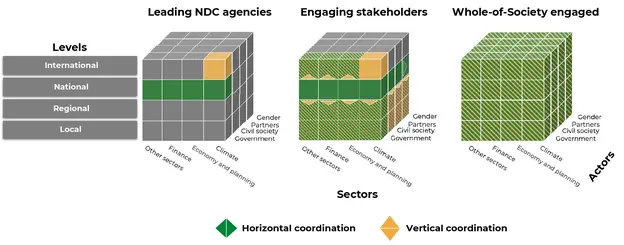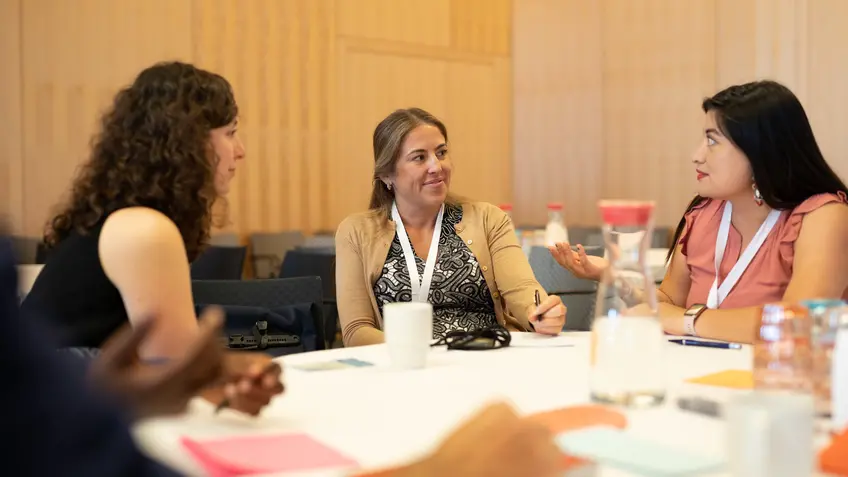Gender Equality and Women’s Inclusion in Stakeholder Engagement
Development and implementation of effective NDCs rely upon collaborative efforts of actively involved stakeholders at all levels (e.g., national, local), across sectors (e.g., climate, finance), and including a diverse array of actors (e.g., government, civil society). A recent NDC Partnership Best Practices Brief outlines approaches and examples of how a whole-of-society approach can contribute to inclusive stakeholder engagement across NDC efforts and phases.

It is no small task to ensure an inclusive approach to stakeholder engagement. It requires a thoughtful plan, fostering a sense of co-ownership and consistent, reliable and transparent communication. A well-developed stakeholder engagement plan should incorporate new actors while deepening engagement with those already involved.
Recognizing Women in NDC Processes
- In a 2021 study, the International Union for Conservation of Nature (IUCN) found that 78% of NDCs reviewed include at least one mention of gender or women, up from 40% of Intended NDCs reviewed in 2016. In their updated NDCs, 43% of those reviewed included women as stakeholders and 5% identified women's organizations and/or gender agencies as implementing partners responsible for specific activities.
- In a 2022 study, Commonwealth Secretariat reviewed updated NDCs from 47 of the 56 Member Countries. While 79% of updated NDCs reviewed include evidence of a participatory planning process, 21% include specific evidence of women’s groups and national women and gender institutions being engaged in the process of updating the NDC (up from 0% of original (I)NDCs reviewed).
Women hold valuable roles at all levels, including those working in public and private sectors, in international organizations and agencies, national and regional governments and as local leaders and household managers. Their sectoral contributions are just as diverse: Women are domestic/community energy and water managers, intergenerational caregivers, STEM and climate professionals, healthcare providers, finance experts and everything in between. Women should be included across sectoral fields, contributing their diverse expertise, experience and perspectives within climate change and sustainable development discussions. Additionally, organizations and agencies that focus on and advocate for women’s issues and gender equality can ensure that these priorities are mainstreamed across all areas of NDC efforts, including stakeholder engagement, to advance climate change goals and the well-being of all communities.
The recently published Best Practices Brief outlines specific strategies and processes for developing an inclusive stakeholder engagement plan, including:
- Mapping stakeholders in an inclusive and participatory process
- Creating enabling conditions for civil society and private sector input
- Incorporating stakeholder engagement in monitoring, evaluation and learning (MEL) efforts for consistent improvements
- Building internal technical capacity to mainstream gender equality and social inclusion in climate policy
Each is critical to embedding gender equity into climate action.
When mapping stakeholders, special care should be taken to ensure that a diverse array of stakeholders are included, especially from often marginalized communities like women, youth, persons with disabilities and others. This mapping should be crosscutting and multilevel — for example, considering women in energy should not only be limited to women as household cookstove actors, but also employed in renewable energy sectors, within energy ministries, etc.
Enabling conditions should be in place to meet the unique needs of civil society actors; they need to be reassured that their rights will be respected and their contributions valued. This includes reducing barriers to women’s engagement, such as considering intersectionality and vulnerabilities, language barriers, physical and emotional safety, childcare responsibilities, etc. Transparency, clear uptake of valuable new ideas and follow-up communication are essential for successful inclusive stakeholder engagement.
MEL processes should include gender equality and social inclusion indicators that are assessed with participation from the communities involved, who can drive consistent data collection and improvement of indicators.
A whole-of-society approach to inclusive stakeholder engagement and a participatory NDC process requires extensive capacity building across levels, sectors, and actors. Capacity building to better understand the linkages between gender equality and climate change–such as ways in which women and men, girls and boys, are differently impacted by climate change effects due to their socio-cultural roles–can support stakeholders to be best prepared to share their insights and priorities, contributing more fully to the NDC process. This can enhance opportunities to highlight existing initiatives that are relevant to NDC goals when those connections may not have been recognized otherwise.
Ecuador pulls together key features of inclusive stakeholder engagement and gender mainstreaming within NDC processes. Ecuador’s Ministry of Environment, Water and Ecological Transition (MAATE) created a Commission on Gender and Climate Change with the support of technical specialists to prioritize gender mainstreaming across national climate action. MAATE and the National Council for Women lead a technical committee that coordinates stakeholders representing public, private, academic and not-for-profit entities. With the support of the NDC Partnership, via the United Kingdom and Canada, a gender advisor embedded with MAATE has supported Ecuador in mainstreaming gender and advancing climate goals across its recent NDC processes.
Further insights into how to apply a gender lens to stakeholder engagement as part of the NDC development process can be accessed through the NDC 3.0 Navigator, recently launched by the United Nations Framework Convention on Climate Change (UNFCCC) secretariat and the NDC Partnership.
As countries reflect on these issues, key questions to consider include:
- What steps can be taken to promote inclusivity across the country’s stakeholder engagement plan and in the NDC 3.0?
- In what ways can a more inclusive stakeholder approach help support the achievement of climate targets (e.g., by identifying existing community initiatives, welcoming diverse voices and ideas, enhancing buy-in of goals, etc.)?
This blog was produced in collaboration with EnGen Collaborative.
Cover photo by: aerogondo / Adobe Stock
